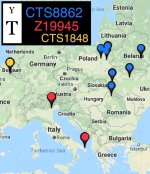Ciao guys, let me tell you, that I got a Y DNA test few years ago and I am T1a M70 (via ftdna). My father line is from Yazd (Iran) and 200 years ago my family were Zoroastrians. So you have to know that since Islam came to Iran, Zoroastrians only marriage with Zoroastrians. Also was Yazd a not important city to conquer for enemies because it's only desert. And Yazd was also a Diaspora point for all religions (sp. Jews) (google Moshee Katzav) a lot of politican of Israel are coming from Iran/Yazd. So actually this area looks very original and they people speaking more clean persian than other Iranians. Yazd and north of Kerman are closed together. Actually we have only 3 areas were the old persians resided, Shiraz, Kerman, Yazd. All other provinces of Iran are more meds/parthians/bactrians and so forth......
my opinion:
we have some old culture who can be T like:
-sumerians
-elamites
-jiroft culture
-kulli culture
but you have to know, in the old levante area were Indo-Europeans not semitic people, the people know speaking semitic languages and got probable more semitic race now, but before semitic people came to this area, they were indo-europeans....
only the semitic people came over egypt to israel, all other people were coming over horn of africa/persian gulf
so amorites, philistines, hurrians, mitanni, kizzuwatna, hittites, arzawaians were all indoeuropeans not semitic
especially the western sience says amorites/phonecians are semitic, iranian science they were indoeuropean, but the etymology is indoeuropean!
but also we have a lot of questions, why the fulbes have a lot of T, and why east indians have a lot of T
the semitic people ruled over the levante area, so they got all semitic languages
the old persians (not iranians(after split)) were coming from the "hamun lake"



